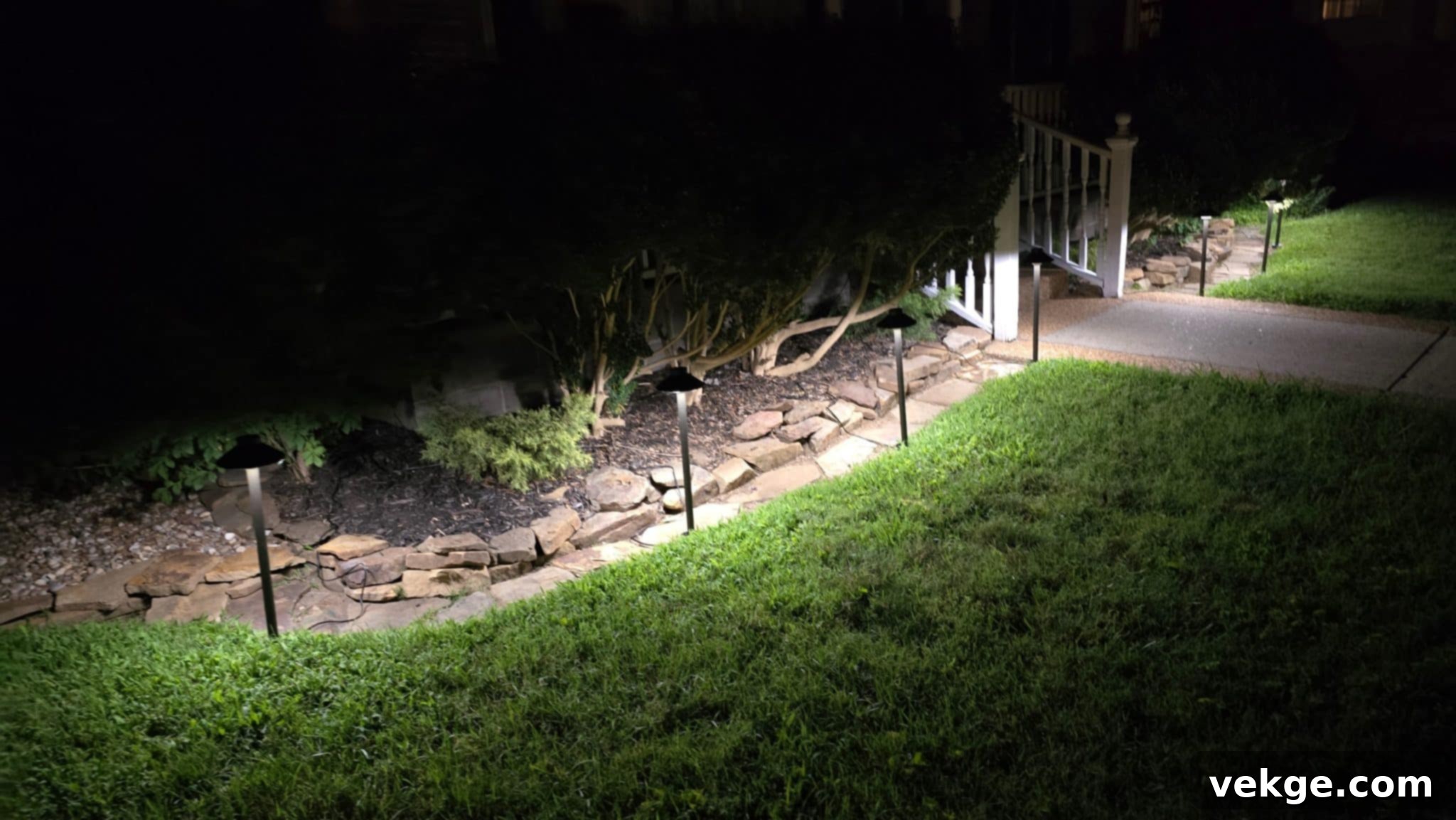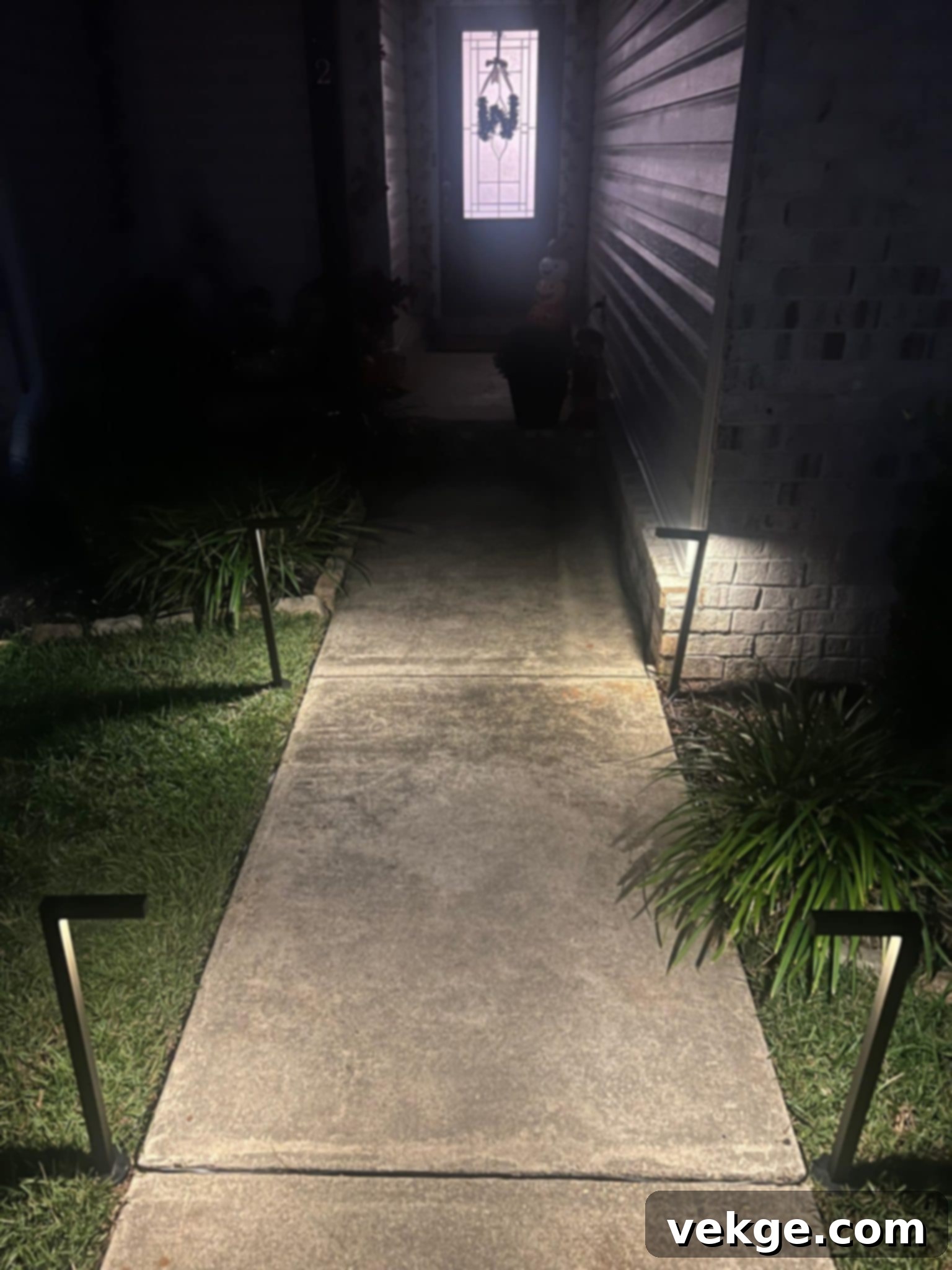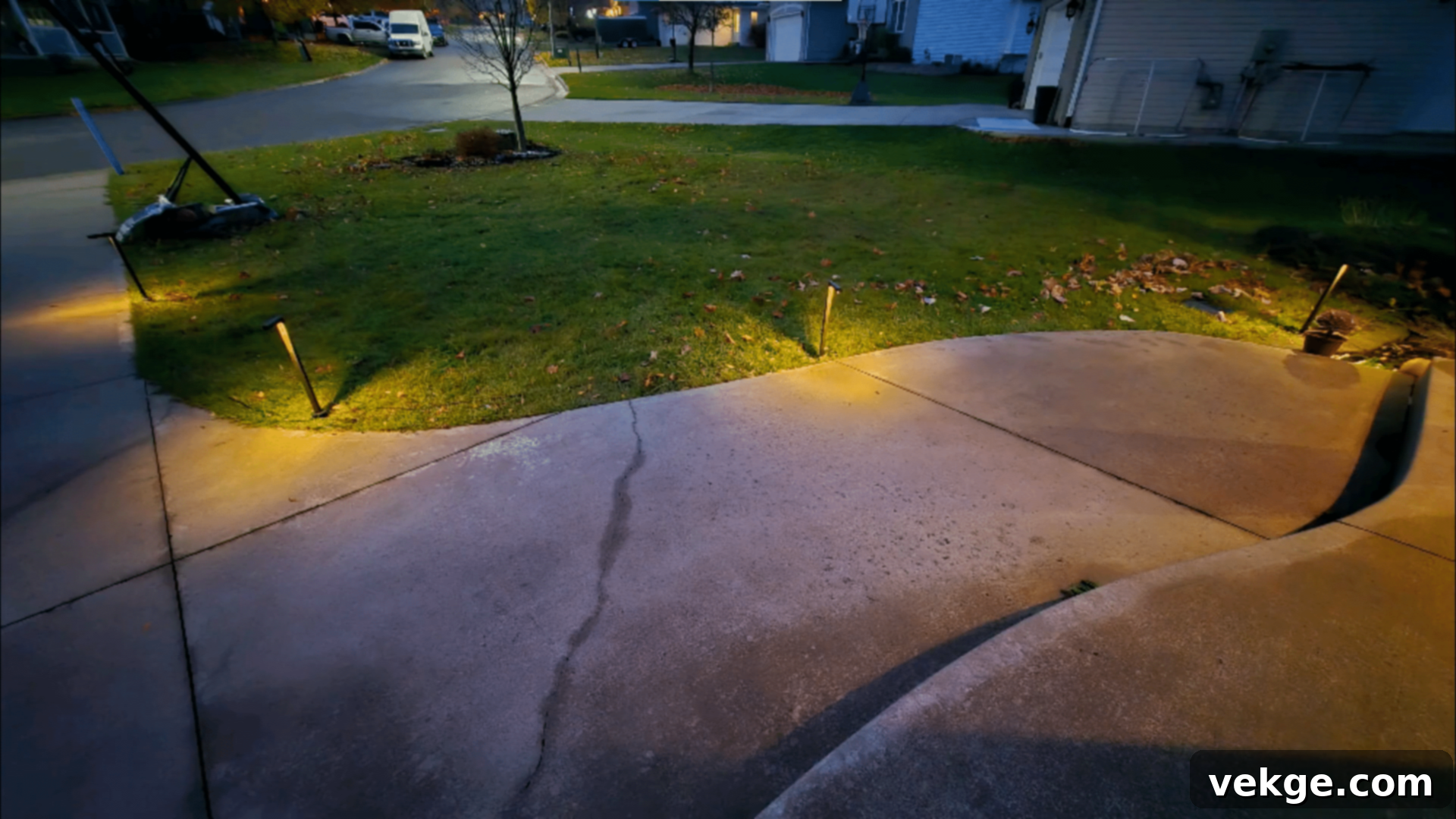The Definitive Guide to Pathway Light Height: Enhancing Safety, Security, and Style
Transforming a house into a warm, inviting home extends far beyond its interior walls. The true magic begins when your outdoor spaces are thoughtfully illuminated, creating an extended living area that’s both functional and beautiful. While many elements contribute to outdoor ambiance, the strategic placement of pathway lights stands out as a fundamental aspect of landscape design. These versatile fixtures offer a perfect blend of safety, security, and aesthetic appeal, guiding your steps while enhancing your property’s overall charm. However, the true art lies in selecting the optimal height for pathway lights to create an inviting, safe, and beautifully lit walkway that complements your home’s unique character and existing landscape.
This comprehensive guide will delve into every crucial step, equipping you with the knowledge to achieve perfectly positioned pathway lights for your gardens, walkways, and outdoor areas. We’ll explore the nuances of various factors that influence optimal height, ensuring your outdoor lighting not only serves its functional purpose but also significantly elevates your landscape’s design and curb appeal. Let’s embark on a journey to uncover the secrets to creating stunning and functional outdoor illumination that will welcome you home every evening.
Why Pathway Lights Are Essential for Illuminating Your Outdoor Spaces
Before diving into the specifics of height selection for your outdoor lighting, it’s imperative to understand why pathway lights are such a valuable and smart investment for any outdoor setting. The outdoor lighting market is experiencing significant growth, with projections from Future Market Insights indicating a healthy CAGR of 7.4% from 2023 to 2033. This growth underscores a widespread recognition among homeowners of the immense benefits that well-designed outdoor lighting brings, transforming simple yards into engaging environments.
Among the myriad of landscape lighting options, pathway lights consistently emerge as a top choice for their immediate and tangible advantages. They are not merely decorative elements; they are integral components of a functional and beautiful outdoor living space. Here’s a closer look at the key reasons why integrating pathway lights into your outdoor design is crucial for safety, security, and superior aesthetics:
Enhanced Walking Safety for Everyone
One of the most compelling reasons to install pathway lights is the significant improvement they offer in terms of personal safety. As daylight fades, pathways can become treacherous, with unseen obstacles, uneven surfaces, steps, or sudden dips posing considerable tripping hazards. This is especially true for the main walkways leading to your front door, winding garden paths, or patio access points. Pathway lights effectively mitigate these risks by casting a soft, guiding glow, ensuring that both residents and guests can navigate your outdoor spaces with confidence and ease after dark. They illuminate potential hazards, clearly define the edges of paths, and prevent unexpected falls, making your property safer for children, the elderly, and anyone unfamiliar with your landscape. This added visibility is not just a convenience; it’s a vital safety measure that protects your loved ones and visitors from avoidable accidents.

Boosted Home Security and Deterrence
Beyond personal safety, pathway lights play a crucial role in enhancing your home’s overall security. A well-lit exterior acts as a powerful deterrent to potential intruders. Darkness provides convenient cover for unwelcome guests, making dimly lit areas prime targets for nefarious activities. By strategically illuminating your pathways, you effectively eliminate shadowy hiding spots and make your property significantly less appealing to criminals. These lights not only guide your way but also cast ample light on approaching figures, making it clear when someone is nearing your home. This increased visibility gives you, your family, and your security systems an advantage, providing invaluable peace of mind and contributing to a safer living environment. In conjunction with other security measures like motion sensors or surveillance cameras, pathway lights create a formidable first line of defense against unauthorized access.
Elevated Aesthetics and Curb Appeal
Perhaps the most visually rewarding aspect of pathway lighting is its ability to profoundly transform the aesthetics of your outdoor spaces. A thoughtfully designed lighting scheme elevates your home’s curb appeal, making it more inviting, picturesque, and welcoming, especially after sunset. Pathway lights contribute to a serene and sophisticated ambiance, highlighting architectural features, landscaping elements, and the beautiful textures of your garden. Whether you desire a soft, romantic glow or a more defined and dramatic effect, the right pathway lights can create depth, focus, and visual interest in your landscape. This isn’t just about functionality; it’s about crafting an outdoor sanctuary that reflects your personal style and enhances the beauty of your property, significantly increasing its perceived value and overall charm. Strategic lighting can even make smaller spaces feel larger and more open, extending your living area into the night.

Key Steps to Selecting the Optimal Height for Pathway Lights
Having established the undeniable advantages of pathway lighting, you’re likely convinced of their value as an essential addition to your landscape. However, the true challenge, and often the most critical decision, comes down to their height. Pathway lights that are too tall can appear awkwardly out of place, creating harsh, blinding glare and failing to properly illuminate the path below. Conversely, lights that are too short might not spread enough light, leaving dark spots, creating a “runway” effect, and ultimately failing to serve their intended purpose for safety and aesthetics. This delicate balance makes choosing the ‘right’ height for your pathway lights a more nuanced and crucial part of the process than simply purchasing the fixtures themselves.
A well-thought-out approach ensures your outdoor lighting system functions optimally and seamlessly integrates with your landscape design, providing both beauty and practicality. Let’s break down the essential steps to guide your selection process and achieve the perfect outdoor illumination:
Step #1: Clearly Define Your Lighting Objectives and Desired Effects
Before you even begin to consider specific light fixtures, the first and most vital step is to clarify your primary objectives for installing pathway lights. Ask yourself: What specific effect am I trying to achieve? Are you primarily focused on ensuring safe passage for everyone using the path after dark? Is your main goal to enhance the decorative beauty and ambiance of your garden, perhaps highlighting specific plantings or architectural elements? Or perhaps you’re looking to achieve a robust combination of both safety and aesthetic appeal?
For instance, if your sole aim is to create a soft, ambient glow that subtly highlights the path’s edges and contributes to a serene, intimate atmosphere, shorter pathway lights (e.g., typically 10-14 inches tall) often achieve this perfectly. These lower fixtures cast a gentle, downward light that minimizes glare and creates a cozy feel. However, if your paramount concerns are clear visibility and enhanced security—such as brightly illuminating a frequently used main walkway or deterring potential intruders—taller pathway lights (e.g., 18-24 inches tall) are generally more suitable. Taller lights can project a wider and more intense beam, ensuring clear visibility over a larger area and significantly reducing dark spots. Understanding your core objective will fundamentally guide your choices in height, light intensity, and the overall type of fixture.
Step #2: Assess the Required Amount of Light and Beam Spread
The next crucial step involves determining the specific amount of light your pathway needs and how that light should be distributed. Pathway lights come with various beam spreads – some designed for a narrow, focused beam, while others offer a wider, more diffused glow. The width and length of your walkway, as well as the presence of surrounding vegetation, will dictate the optimal light spread required for full illumination without creating excessive hotspots (overly bright areas) or dark zones. For wider paths, you might need lights that produce a broader beam or simply more fixtures spaced appropriately to achieve uniform coverage. Consider the “cutoff” point – where the light effectively ends. Ideally, pathway lights should provide consistent illumination across the walking surface without light spilling excessively into surrounding areas or upwards into the sky, which contributes to light pollution. Taller fixtures can sometimes achieve a wider spread from a single point, but they also increase the potential for glare. Conversely, shorter fixtures offer a more controlled, downward light but may require closer spacing to cover the same area effectively, especially on wider paths.

Step #3: Precisely Measure Your Pathway Width and Length
The physical dimensions of your pathway are paramount in determining the ideal height and spacing for your lights. As a general rule, wider paths often necessitate taller lights, or more frequently, a greater number of lights positioned strategically to ensure comprehensive coverage. Conversely, narrower pathways can typically be adequately illuminated with shorter fixtures or fewer lights without creating over-lit areas. The overarching goal is to uniformly illuminate the entire walking surface, preventing unlit gaps in the center or along the edges, which can compromise safety and aesthetics. To achieve this precision, it’s highly recommended to use a tape measure to accurately record both the width and length of your path. This measurement will provide a clear, data-driven foundation for calculating the optimal height and spacing of your fixtures. A common guideline suggests that for most residential pathways, lights placed every 6-8 feet will create a consistent glow. However, this spacing needs to be adjusted based on the fixture’s specific beam spread and chosen height. Experimentation with temporary lights or even stakes at different heights can be invaluable during this planning phase, allowing you to visualize the effect before permanent installation.
Step #4: Select the Appropriate Style, Material, and Fixture Design
Beyond functionality, the aesthetic contribution of your pathway lights is undeniable, playing a crucial role in your home’s overall curb appeal. The style and material of the fixtures should harmonize seamlessly with your home’s architectural design and your landscape’s overarching theme. When choosing, prioritize durability; robust materials like durable brass, copper, or stainless steel offer maximum longevity and resistance to the elements, making them a worthwhile long-term investment. Consider how the fixture’s specific design influences light distribution: “mushroom” or “pagoda” style lights typically cast a broad, downward glow, ideal for general path illumination, while “dome” or “bullet” lights might offer a more focused beam for accenting specific features or plants.
Classic pathway lights often range from 15 to 20 inches tall to ensure an even spread of light across a typical pathway without glare. If your objective is a more subtle, decorative glow, shorter decorative lights, perhaps 10-14 inches, can create a charming, understated effect. For specialty path lights or unique landscape features, it’s crucial to conduct a trial placement. Hold them at various heights along your walkway to visualize how they integrate with your overall landscape design and whether they maintain the desired lighting efficiency and visual appeal. The aim is to choose fixtures that not only deliver the right amount and spread of light but also enhance the daytime visual appeal of your outdoor spaces, becoming attractive elements in themselves.
Step #5: Integrate Height with Your Existing Yard and Landscape Elements
The final, and arguably most artistic, step is to select a height that seamlessly integrates with your specific yard and its various landscape elements. This step is about considering the bigger picture – your existing plants, shrubs, trees, garden beds, and any architectural features along the path. If your goal is to highlight your home’s exterior, illuminate a tall hedge, or simply have the lights rise above mature groundcover, taller path lights (e.g., 18-24 inches) will prove highly effective. These fixtures can project light over common obstacles and illuminate a broader area, creating a dramatic and welcoming effect as evening descends. They prevent the light from being obscured by burgeoning foliage and ensure the path remains clearly visible, especially important for security.
Conversely, if your pathway is narrower, flanked by low-lying plants, or if your top priority is a subtle, glare-free illumination for safety without drawing too much attention to the fixtures themselves, shorter lights (e.g., 10-15 inches in length) will be the superior choice. These low-profile lights sit below most plants, preventing them from being overgrown and ensuring a focused, gentle glow that perfectly outlines the path. Always consider the maturity and growth patterns of your surrounding plants; what seems like the right height today might be completely obscured by overgrown shrubs next season. Thinking ahead about your landscape’s evolution will help you make a more enduring choice for your pathway lighting ideas, ensuring lasting beauty and functionality.
Beyond Height: Additional Considerations for Optimal Pathway Lighting
While selecting the right height for your pathway lights is paramount, a truly optimal pathway lighting system incorporates a few other key elements to ensure maximum effectiveness and aesthetic appeal:
- Spacing: The distance between individual lights is as critical as their height. Improper spacing can lead to “runway” effects (where lights are too far apart, creating dark gaps) or over-illumination (where lights are too close, creating uncomfortable hotspots). As a general rule, position lights so that their light pools slightly overlap, creating a continuous, even wash of light along the entire path.
- Bulb Type and Brightness (Lumens): Modern LED pathway lights offer superior energy efficiency, impressive longevity, and a wide range of options. The lumen output (brightness) should be appropriate for the path’s needs – typically 70-150 lumens for ambient pathway lighting. Lights that are too bright can cause glare, while those that are too dim will be ineffective in providing adequate illumination.
- Color Temperature: This refers to the “warmth” or “coolness” of the light, measured in Kelvin (K). Warmer temperatures (e.g., 2700K-3000K) produce a softer, more inviting ambiance, mimicking traditional incandescent light, which is generally preferred for residential landscapes to create a welcoming feel. Cooler temperatures (e.g., 4000K+) appear brighter and more clinical, often reserved for security or task lighting in commercial settings.
- Installation Method: While beyond the scope of height, understanding that proper wiring, appropriate voltage (low-voltage systems are common, safe, and efficient for DIY), and secure mounting are essential for the longevity, performance, and safety of your lights. Consult a professional if you’re unsure about the electrical aspects.
- Glare Control: A well-designed pathway lighting system should ensure that the light source itself is not directly visible to observers when looking down the path. Shielding, frosted lenses, or specific fixture designs (like those that direct light downwards) can help diffuse light and minimize uncomfortable glare, making the pathway more pleasant and safe to navigate.
Final Thoughts on Perfecting Your Pathway Lighting Design
Choosing the right height for pathway lights may not be rocket science, but it certainly demands a thoughtful, step-by-step approach. It’s an integral part of creating an outdoor environment that is not only visually stunning but also safe, secure, and wonderfully inviting. Remember, a truly effective and beautiful outdoor lighting scheme isn’t achieved by randomly placing fixtures; it’s the result of carefully considering your specific lighting objectives, understanding the intricate interplay between light spread and path dimensions, and harmonizing the chosen fixtures with your unique landscape design.
By meticulously measuring the width of your path, assessing the amount of light required for both functionality and ambiance, and strategically spacing your chosen fixtures, you can craft perfectly lit walkways that enhance your home’s curb appeal, significantly boost safety, and provide a welcoming glow for years to come. Investing time and thought into this planning phase will ensure your pathway lighting installation yields maximum benefits and truly transforms your outdoor living experience, making your home stand out day and night.
Ready to bring your pathway lighting vision to life? Explore the extensive range of high-quality pathway lights at Gardenreet. Discover the perfect fixtures to illuminate your pathways and create your own stunning, functional, and inviting outdoor spaces!
